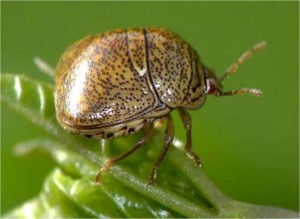Kudzu bug was first seen in Atlanta, Georgia in 2009. Currently, this plant pest and home invader has spread rapidly through the southern U.S. (to Texas) and as far north as eastern Maryland and southern Delaware. Kudzu bug belongs to the shield bug family (Plataspidae), but does emit a strong odor. It secretes a noxious chemical that can cause eye and skin irritation.
The bug prefers to feed on legume plants in the legume family such as redbud, yellowwood, black locust and wisteria and crop plants like soybeans and lespedeza. It will devour an entire hillside of kudzu where it likes to overwinter. In North Carolina adults emerge in May and produce two generations per year.
In the spring adults emerge from protected overwintering sites in search of kudzu and to mate and lay eggs. A second generation moves into soybean or other bean fields later in the summer. In the fall, the bugs return to kudzu or protected areas such as plant debris, tree bark, homes or other structures. Kudzu bugs are drawn to light colors, and can become a major home invader.
Since kudzu bug is a recent pest in the U.S., management options are currently being worked out. Pyrethroid insecticides appears to be effective against kudzu bugs. Young nymphs seem to be the most susceptible stage. In the fall pyrethroids can also be sprayed on exteriors of houses where kudzu bugs are congregating. Use any insecticide according to labeled directions for the crop. Removal of kudzu in areas adjacent to fields is recommended when possible since this is the first host plant the insect seeks after emerging from its overwintering location.
Special thanks: Mr. John Rochelle and Adam Blalock for information contained in this blog.


 Posted in
Posted in 
